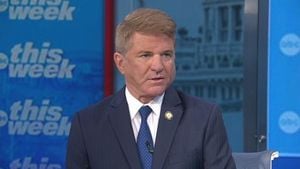The call for advancing renewable energy sources has become more urgent as regions grapple with increasing electricity needs and grid stability. Recent discussions among Russian officials underscored this issue, particularly for the Far East, where economic development hinges on reliable energy supply.
During this roundtable, Russian Energy Minister Sergey Tsivilev and Minister for the Development of the Far East and Arctic Alexey Chekunkov focused on electricity generation as pivotal for economic resilience. Tsivilev pointed out, "Мы обсуждаем одну из наиболее актуальных тем для экономического укрепления Дальнего Востока — развитие электроэнергетики." This reflects the seriousness with which these factors are currently regarded.
According to government forecasts, electricity demand will rise significantly across various regions, making conversations about energy production not only timely but necessary. Tsivilev has highlighted the government's plan to ramp up the renewable energy generator count and improve grid reliability by 2042.
One proposed strategy involves converting energy infrastructure to include gas alongside the development of wind and solar installations. This approach aims at decreasing dependency on less sustainable sources, aligning officials with commitments to achieve greater clean energy outputs.
On the other side of Europe, Germany has reported impressive figures as well. Recently, nearly two-thirds of the electricity produced came from renewable sources, peaking at 63.4% this past third quarter, thanks to favorable weather conditions. The Federal Statistical Office indicated the share of wind energy rose to 24.7%, making it the principal component among renewables.
"Увеличение выработки энергии с помощью фотоэлектрических и ветровых установок связано с неожиданно солнечными и ветреными месяцами в третьем квартале 2024 года," elaborated by the DPA agency, showcasing the significant impact of seasonal weather patterns on energy production capabilities.
Despite these successes, concerns linger about vulnerabilities within marine energy infrastructure. With approximately 1,600 wind turbines operating at sea, German authorities are wary of potential sabotage or accidents, especially following recent incidents leading to cable damages.
“Желающие подорвать работу такой критически важной инфраструктуры, скорее всего будут стремиться нанести как можно больший урон. Они нацелены на провода,” said BWO executive director Stefan Timm. This reality highlights the dual approach necessary not only to build but also to protect renewable energy's backbone.
Successfully combining growth with security on energy fronts requires foresight and innovation. With many countries revisiting their energy strategies, renewable source production can no longer be treated as supplementary or secondary. It must become central to energy policy, especially as events across the globe reveal delicate balances between energy provision and sustainability.
Meanwhile, Russian energy dynamics continue to evolve. Alexey Zhikharev, director of the Association of Renewable Energy Development, commented, "Солнечная и ветровая генерация может решить проблему дефицита электроэнергии." His insights reflect the growing acknowledgment of renewables as viable solutions to meet rising demands.
While various geopolitical and economic factors play roles, the clear pathway forward involves enhancing renewable generation capacities. Building infrastructure to handle renewable sources, like those already operational or proposed for the Far East, will help stave off energy shortages.
Comparatively, both regions see the need to adapt energy production to meet increasing consumption rates effectively. Wisdom lies not just within developing these energy resources but ensuring they are resilient enough to withstand storms—literal and metaphorical—that test their preparedness.
Such discussions, held at the highest government levels, forge the path for future energy security. By fortifying investments and focusing on renewable energy integration, regions will be ready for tomorrow's energy challenges.



